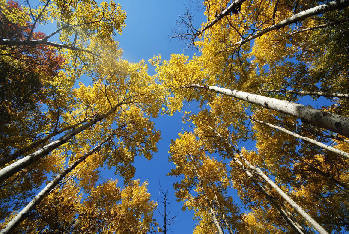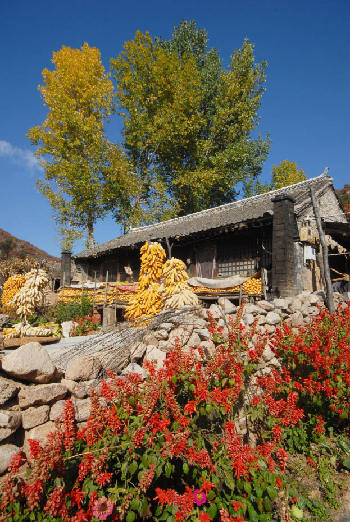Discovering Labagoumen
 |
| Towering golden-leaved birch trees in Labagoumen. |
LABAGOUMEN, located in Huairou District, is the northernmost town in the municipality of Beijing. Bordering Hebei Province, it lies 150 km from the heart of the capital. The name Labagoumen describes its geographical characteristics: The town is embedded in a trumpet-shaped valley (laba means trumpet and gou means valley in Chinese); moreover, it is precisely at the entrance (men means door) of that “trumpet.”
Labagoumen is now the largest community of the Manchu ethnic group in Beijing. Of its 60 villages, 10 are inhabited predominantly by the Manchus.
With vast forests, springs, clean air, and a comfortable climate (around 20 °C in summer), Labagoumen is known as a “longevity town” in northern China and is attracting more and more tourists.
The rambling Labagoumen National Forest Park occupies more than 60 percent of the total area of the town.
 |
|
A characteristic dwelling in Sunzhazi Village. |
Mountainous Landscapes
Labagoumen’s magnificent mountain scenery immediately captivates visitors. In October, the forests become multicolored. Green, red, and yellow hues against the blue sky form a painter’s palette.
Many Beijingers regard Labagoumen as their “rear garden,” somewhere pleasant to take a stroll at the weekends. From the capital, the G111 National Highway leads to Huairou’s northern mountainous area and in just two hours’ drive, a completely different view appears.
Most tourists choose to homestay in the village of Sunzhazi near the national park. In this park, there are two main places of interest: Fenghuang (Phoenix) Platform and Wulongtan (Pond of Five Dragons) Lake. Fenghuang Platform, three km from Sunzhazi, is the most popular sight. The scenic spot also contains the largest white birch and oak forests in Beijing. The foliage of these trees changes color in the autumn: The birch leaves turn a shimmering gold, and oak leaves flame-orange. The temperate mountain ecosystem of the area allows rich fauna and flora to thrive.
Explorers can follow an upward path, pause at a pavilion on the hillside, and then climb to the top of Nanhouding. At an altitude of 1,700 meters above sea level, it is the highest mountain in Huairou and the fourth highest in Beijing.
After crossing a forest of tall trees, we arrive at a high mountain steppe. Our vision is suddenly illuminated as we progress towards the ridge, tall grass brushing our calves and breeze caressing our hair. Such pleasant sensations make it a dream for hiking. As we approach the peak, we distinguish a pile of large rocks. Taking a closer look, it seems that this is no scree-fall, but a mysterious piece of work, each rock having been meticulously placed.
After much effort, we finally reach the top and a huge rock of 10 meters across offers a platform to better appreciate the landscape of endless mountains.
